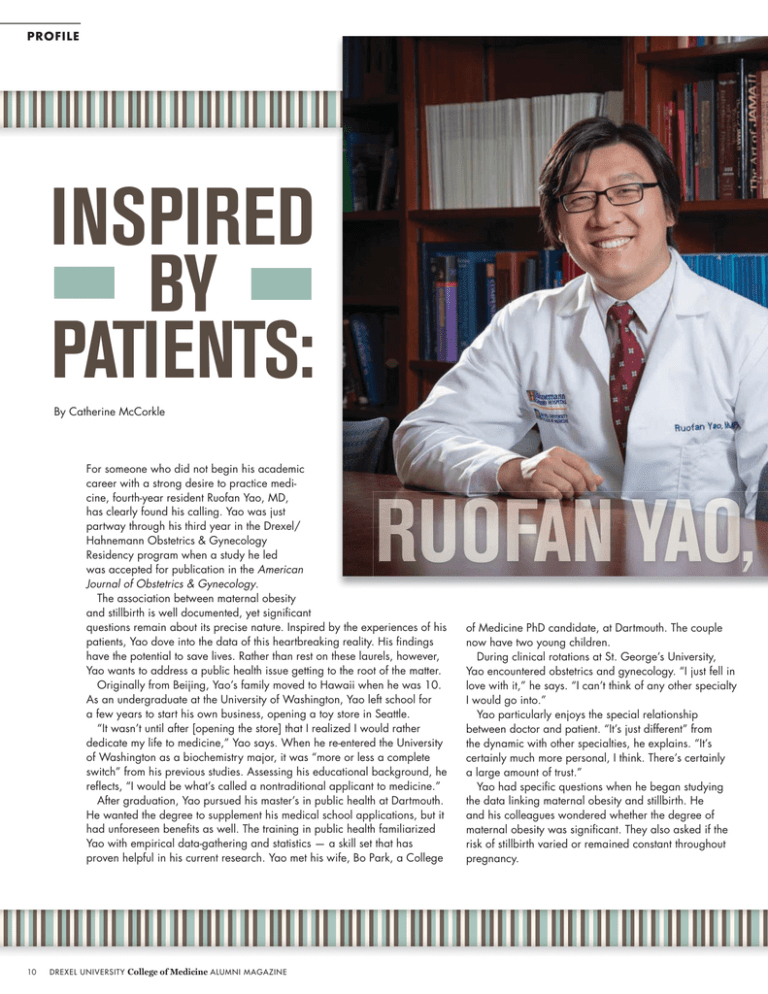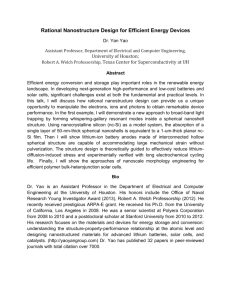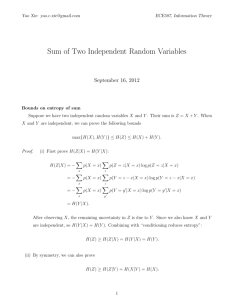INSPIRED BY PATIENT S:
advertisement

PROFILE INSPIRED BY PATIENTS: By Catherine McCorkle For someone who did not begin his academic career with a strong desire to practice medicine, fourth-year resident Ruofan Yao, MD, has clearly found his calling. Yao was just partway through his third year in the Drexel/ Hahnemann Obstetrics & Gynecology Residency program when a study he led was accepted for publication in the American Journal of Obstetrics & Gynecology. The association between maternal obesity and stillbirth is well documented, yet significant questions remain about its precise nature. Inspired by the experiences of his patients, Yao dove into the data of this heartbreaking reality. His findings have the potential to save lives. Rather than rest on these laurels, however, Yao wants to address a public health issue getting to the root of the matter. Originally from Beijing, Yao’s family moved to Hawaii when he was 10. As an undergraduate at the University of Washington, Yao left school for a few years to start his own business, opening a toy store in Seattle. “It wasn’t until after [opening the store] that I realized I would rather dedicate my life to medicine,” Yao says. When he re-entered the University of Washington as a biochemistry major, it was “more or less a complete switch” from his previous studies. Assessing his educational background, he reflects, “I would be what’s called a nontraditional applicant to medicine.” After graduation, Yao pursued his master’s in public health at Dartmouth. He wanted the degree to supplement his medical school applications, but it had unforeseen benefits as well. The training in public health familiarized Yao with empirical data-gathering and statistics — a skill set that has proven helpful in his current research. Yao met his wife, Bo Park, a College 10 DREXEL UNIVERSITY College of Medicine ALUMNI MAGAZINE of Medicine PhD candidate, at Dartmouth. The couple now have two young children. During clinical rotations at St. George’s University, Yao encountered obstetrics and gynecology. “I just fell in love with it,” he says. “I can’t think of any other specialty I would go into.” Yao particularly enjoys the special relationship between doctor and patient. “It’s just different” from the dynamic with other specialties, he explains. “It’s certainly much more personal, I think. There’s certainly a large amount of trust.” Yao had specific questions when he began studying the data linking maternal obesity and stillbirth. He and his colleagues wondered whether the degree of maternal obesity was significant. They also asked if the risk of stillbirth varied or remained constant throughout pregnancy. Jim Greipp Resident Ruofan Yao’s research into obesity and stillbirth is nuanced in a way that previous studies have not been. The Yao study analyzed more than 9,000 stillbirths and included close to 3 million live births. In addition to its breadth, Yao’s research is nuanced in a way that previous studies have not been. In earlier studies, all overweight women were identified as obese. Whether “your BMI was 30 or if your BMI was 50” did not matter, says Yao. In his study, women were organized into six categories by weight, with four categories identifying a range of obesity. Other studies did not recognize individual gestational weeks. There was no distinction between a stillbirth at week 20 or at week 40. By contrast, Yao’s study has data for every gestational week. In this manner, he says, “We’re able to tell what a woman’s specific risk for stillbirth is any given week during her pregnancy, as long as we know her BMI.” Identifying a precise risk factor based on a woman’s BMI and gestational week is a boon to both doctors and patients. “We can tell you exactly what the risk is. We can tell you exactly which week your risk starts to go up,” Yao explains. This information can offer a guideline for physicians to discuss induction with a patient. Yet induction, as Yao recognizes, addresses the problem at the end of the story rather than at the beginning. He suggests that doctors — himself included — “don’t spend nearly enough time talking to women before their pregnancy about what their risks are and how we can reduce that risk.” Getting closer to an optimal weight can greatly reduce a woman’s chance of stillbirth. “A lot of women are motivated [to make changes] to have a healthy pregnancy outcome,” Yao says, but if the doctor does not introduce the idea of obesity being a risk, the patient assumes her weight is acceptable. When physicians initiate that conversation, the mothers are much more willing to change. Even a loss of 10 pounds can make a difference. In Hahnemann’s ob/gyn clinics, about half the pregnant women seen are obese. Many of them could be considered severely obese; some have BMIs of up to 80. “As a public health issue for [Philadelphia], that’s a big problem,” explains Yao. “It’s not just about stillbirths. It’s not just about what happens during the pregnancy, either.” While Yao sees a relatively small segment of the population as an ob/gyn, his patients are representative of the city. “We see 18-year-olds with diabetes, chronic hypertension, congestive heart failure,” he reveals. “They’re 18. I think if people love the city of Philadelphia, this should be an issue they consider addressing.” One of the best things for Philadelphia may be for Yao to keep asking questions. “We can tell you exactly what the risk is.” DREXEL UNIVERSITY College of Medicine ALUMNI MAGAZINE 11




